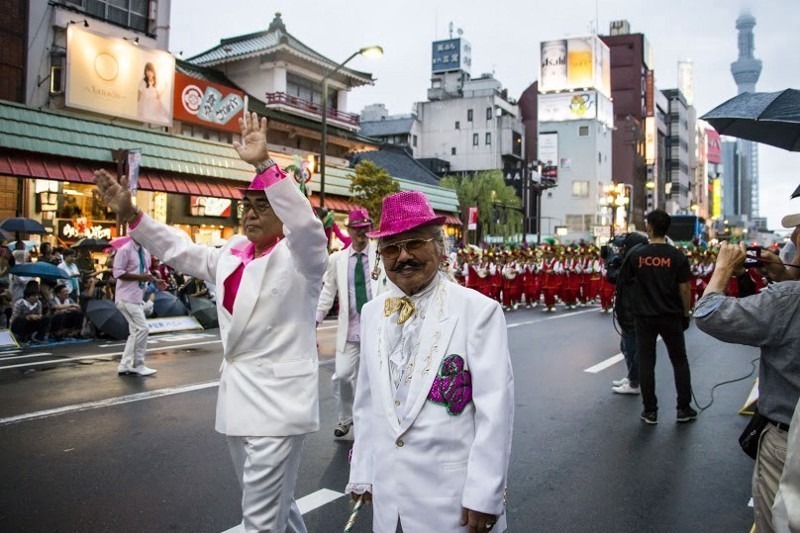Even though I’ve lived in Japan for many years now, it was only a few years ago, mainly through having seen him appear on an especially creative television campaign for Sony, that I became aware of the existence of a rock star named Eikichi Yazawa. Afterwards, I realised that his face is everywhere. He’s been hugely popular since the 70s, is still highly relevant, and there’s no nice way of putting it — he’s getting kind of old.
But Yazawa is at the forefront of a generation redefining what it means to be ‘old’. Yazawa, who was born in 1949, is a member of what is known as the Dankai generation. The Dankai are a very large cohort of around 7 million people born between 1947 and 1949 — essentially Japan’s first baby boom. In 2007 these people started retiring, and this was widely predicted as a tipping point in Japan’s social, demographic and economic structure.
But a tipping point towards what?
Already, in aggregate terms, older generations are contributing a more important share of consumer spending every year — not least because they are getting to be so numerous. It seems that products such as health supplements, pharmaceuticals, skin creams, mobility aids, cruises, personal development classes etc (the list goes on and on,) are in for a sustained boom for years to come. Supporting this idea, according to Unicharm, a sanitary goods manufacturer, adult diapers have started to outsell baby diapers in Japan!
Although the demographic trends are both current and particularly extreme in Japan, they will be reflected throughout the developed world relatively soon. It looks as if a “Wrinkly Revolution” is going to start here and that marketers in Japan should be able to use this to foster a sustainable edge in innovation.
A poster child for this revolution, Yazawa is a mature, yet cool and young-at-heart rebel that, even if their lives look nothing like his, the Dankai identify with. He defies the stereotypical ‘senior citizen’, often portrayed as being passive, frail and sickly. The Dankai, who do not wish to be made to feel old, recoil at things that are obviously marketed only towards seniors.
Responding to this, when Docomo first released the Raku-Raku-Hon, a mobile phone designed for seniors, they hired Kenya Hara, a famous designer known for his work with Muji. Although there was much objection from his peers, such as ‘it’s an insult to Mr Hara’ and ‘a mobile phone for seniors doesn’t need good design’, Hara was determined to respond to what he heard directly from senior customers- ‘It’s nice that it’s easy to use, but since it’s something I carry around every day, I also want it to be stylish’. This opened up a whole new market of mobile phone users, with the series always ranking in the top ten best sellers. This August, Docomo released Raku Raku Smartphone F-12D and they aim to sell about 500,000 phones this year alone.
There are some counter-revolutionary factors at play though. One is that older people are, in larger numbers, simply not retiring. This means that all the anticipated leisure hours marketers are seeking to help the Dankai fill are being replaced for many by what they know best — work. This is consistent with a generation that, while it may have worn the fashions and listened to the music of the 60s and 70s, never really rebelled. There were no “summers of love” in Japan and, by and large, the Japanese baby-boomers played by the rules and know more about saving than spending. We shouldn’t necessarily anticipate the rise of the American-style “self-indulgent boomer” in Japan.
Younger generations, especially those graduating from university nowadays, face a much bleaker economy and have a much less optimistic world-view than the relatively fortunate Dankai. So it’s not unlikely that the wealthy Dankai and those that follow will end up spending not only on themselves, but also on their children. Are we going to see the rise of an abstemious “compassionate, self-sacrificing boomer” in stark contrast to their American counterparts?
Nevertheless, the endurance and continuing relevance of Yazawa gives us some reason to hope that the older generations in Japan can resist being more than just a growing market for the tools and aids of old-age. There are dreams that are yet to be fulfilled among these people, and in many ways it is condescending to think that it is the job of those managing brands today to work out how to “deal” with this huge group. Perhaps the real answer to the future will lie in innovations created by the aged for the aged. For marketers, co-creation and collaboration with older people is where we’re really going to re-write the book about ageing, and this is a process that has really only just begun.
CarterJMRN is a strategic market research agency that has been helping clients with consumers and businesses in Japan and beyond since 1989.
We believe that, although the terrain you face in building a successful marketing strategy and activation path sometimes seems obscure, the path to success is knowable and that the consumer is the guide who will show you the way.
Find out more and get in touch on our site

